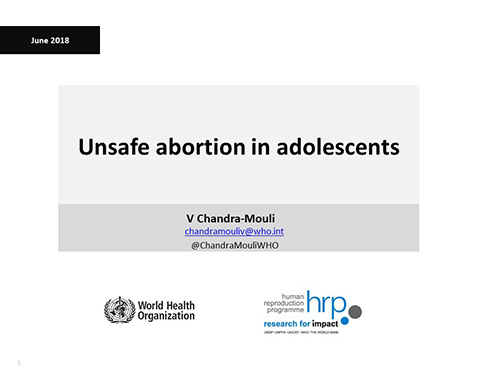Adolescent sexual and reproductive health - Course files
Unsafe abortion in adolescents
Venkatraman Chandra-Mouli
Training course in adolescent sexual and reproductive health 2018
June 25, 2018 - Geneva
Download the complete document
Chandra-Mouli V. Unsafe abortion in adolescents. Paper presented at: Training course in adolescent sexual and reproductive health; 2018 Jun 25; Geneva.
Topics
- How many unsafe abortions occur in adolescents? And where do they occur?
- What are the consequences of unsafe abortion in adolescents?
- Why do unintended pregnancies occur in adolescents? How could they be prevented?
- Why do unsafe abortions occur and why are they more likely to result in serious complications in adolescents? How can they be prevented?
Essential reading
1. Compilation of the WHO’s current recommendations on Adolescent Sexual and Reproductive Health
The Compilation of the WHO’s Current Recommendations on ASRH provides an overview of sexual and reproductive health issues that may be important for the health and well-being of adolescents (ages 10-19 years) and the relevant WHO guidelines for how to address them in an easily accessible, user-friendly, and short format. This document serves as a gateway to the WHO’s rich body of guidelines, and as a handy resource to inform advocacy, policy and programme/project design and research.
This document is intended to be used by policy-makers and decision makers in Ministries of Health responsible for ASRH policies and programmes, international and national nongovernment organizations carrying out ASRH projects, and international organizations that provide technical and/or financial support for ASRH work. It is intended to be accessible for those with or without expertise in ASRH. It is not intended as a technical reference for frontline professionals, such as health service providers, teachers or community development professionals.
In line with the WHO Operational Framework on Sexual Health and its Linkages to Reproductive Health, this document compiles WHO’s recommendations on the following issues:
- Comprehensive education & information provision
- Contraception counselling & provision
- Antenatal, intrapartum, & postnatal care
- Safe abortion care
- Sexually Transmissible Infections (STI) prevention & control
- HIV prevention & control
- Violence against women and girls prevention, support & care
- Harmful traditional practices prevention
For each issue, this document outlines:
- Definition(s)
- Rationale
- Relevant WHO guidelines
- Key concepts to consider
- Key complementary documents in addition to the WHO guidelines
- Real-life application of the guidelines
2. Abortion care for young women: A training toolkit
This toolkit has been developed by the IPAS. It was published in 2011.
It has been designed to provide information and guidance on delivering and ensuring access to appropriate induced abortion care for young women (ages 10-24). It provides experienced trainers with the background information, materials, instructions and tips necessary to effectively facilitate training sessions.
Since existing research demonstrates few differences in the clinical needs of young women compared to adults, the toolkit contains more on advocacy, partnerships and service delivery than clinical issues. It is a global resource for health care providers, trainers, administrators and technical advisors of abortion care programs, but some materials also can be used to engage young people, policymakers, community groups, donors, advocates and other stakeholders.
Assignment
Option 1:
Please respond to this if you are a health worker (doctor, midwife, nurse, clinical officer, psychologist, health educator) or social worker.
Are you aware of your country’s laws and policies on the provision of abortion services? If so, please list the conditions under which abortion services can be legally provided in your country.
Option 2:
If you are not a health worker, please cite a recent article in the media in which abortion is discussed and write a commentary on it.
